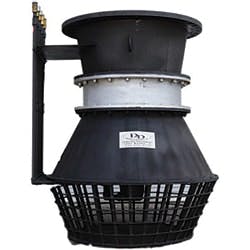Clarksville, Tenn., experienced unprecedented flooding as the Red River crested in May 2010. When the river was at its highest, Clarksville’s wastewater treatment plant, which treats an average of 12 to 15 mgd, with peak of 25 mgd, was submerged in 20 ft of standing water that damaging the entire facility. This includes damage to the roof atop the facility’s main office, which became detached when an air bubble was trapped inside the building by the rising water. During the flood, the plant experienced flows in excess of 70 mgd, the maximum rate able to be registered by the facility’s flow meter.
Bill Summers, city councilman in Clarksville, estimated that the cleanup and restoration of this facility may cost $20 to $30 million and take at least 18 months to complete. All motors, pipes and other facility equipment must be disassembled, cleaned and reassembled; massive storage containers must be cleaned and decontaminated; 15,000 air diffusers must be replaced; and secondary clarifiers must be cleaned, purged and introduced to new bacteria. Cleanup efforts also include removing, decontaminating, disinfecting, flushing, reinstalling and inspecting all transformers, switch boxes, power cables and generator lines while the wastewater treatment plant’s power is temporarily supplied by generators.
Allied Technical Services Inc./Allied Pump Rentals is one of the companies involved in restoring Clarksville’s wastewater treatment plant. Allied installed a temporary primary sludge conditioning tank and pumps to allow the treatment plant to resume some part of its normal wastewater treatment process. The need for flexibility and easy installation made a wireless solution from Banner Engineering ideal for this project, as the wireless devices would be used for monitoring the levels in the permanent sludge tanks and controlling the feed pumps.
Once Allied determined the Banner SureCross Wireless Network devices best suited for data acquisition and monitoring in this application, a wireless solution was installed and working within two hours. Float switches inside the temporary sludge tanks monitor the sludge levels and are connected to a 900-megahertz battery-powered wireless node. The node transmits data back to a wireless Gateway, as well as an HMI by Red Lion Controls, which is installed in the primary clarifier pump house a quarter mile away. Tank level data is displayed graphically and pumps are automatically cycled on or off based on the sludge tank levels.
This wireless data collection solution eliminated the need for personnel to monitor each sludge tank on-site 24 hours a day. Automating the transfer process using wireless technology allows all tank data to be sent to a centralized location, which allows one employee to monitor multiple processes.
A second wireless application was identified to aid in drying out buildings using large dehumidifiers. A FlexPower node and temperature/humidity sensor monitored the humidity levels inside buildings during the restoration process. As one building was dried, the easy-to-install FlexPower node and temperature/humidity sensor was moved to another building.
A third wireless node is used to send gravity belt thickened sludge to the temporary blending tank.
“Due to the length of time the plant was submerged, all electrical wiring was removed. During this process and after it would have been almost impossible to have maintained a hardwired data highway system,” said Doug Sayre of Allied. “The Banner wireless system is capable of up to 56 nodes, which will allow me to provide almost any imaginable process or data point needed as we bring the plant back online. With the administration building being condemned and torn down, plus a new sludge treatment process in use, hard wiring was not practical.”
Along with these wireless network devices and many infrastructure repairs at the wastewater facility, a new floodwall will be added to prevent a reoccurrence.
Source: Banner Engineering


